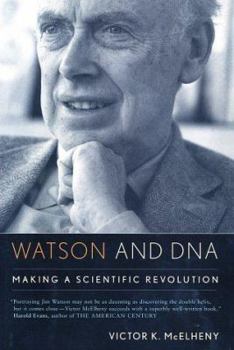Watson and DNA: Making a Scientific Revolution
Select Format
Select Condition 
Book Overview
A riveting portrait explores the man behind the greatest scientific achievement of our time: the discovery of the structure of DNA and the creation of modern molecular biology. Two 8-page photo... This description may be from another edition of this product.
Format:Hardcover
Language:English
ISBN:0738203416
ISBN13:9780738203416
Release Date:January 2003
Publisher:Basic Books (AZ)
Length:365 Pages
Weight:1.54 lbs.
Dimensions:1.3" x 6.3" x 9.3"
Related Subjects
Biochemistry Biographical Biographies Biographies & History Biography & History Biological Sciences Biology Evolution Genetics Health, Fitness & Dieting Health, Fitness & Dieting History & Philosophy Memoirs Molecular Biology Professionals & Academics Science Science & Math Science & Scientists Science & Technology ScientistsCustomer Reviews
2 ratings
breakthrough and epilogue
Published by Thriftbooks.com User , 19 years ago
For anyone else, a career that includes a stint at Harvard as a professor and mentor to numerous successful scientists, several decades spent rebuilding Cold Springs Harbor Laboratory into a world-renowned scientific center, and the opportunity to steer the Human Genome Project, would be considered a tremendous success. For James Watson, that was all just an epilogue to his Nobel Prize-winning deduction of the structure of DNA. Double Helix, Watson's million-selling account of this breakthrough, is one of the most compelling books ever written about science. Genes, Girls and Gamow, his recent book about his subsequent career, does not have the same power. Victor McElheny largely covers the same periods that Watson describes in his autobiographical works, but he adds more description of Watson's education and concentrates more on his professional career. The book is well-researched and informative; McElheny interviewed scores of Watson's associates and pored over previous reminiscences by Watson and Crick, among others. A previous employee and a longtime admirer of Watson's, McElheny occasionally veers toward hagiography, but he is generally balanced in his portrayal of the eccentric scientist. Unfortunately, the biography suffers from several flaws that are no fault of the author. Watson was working on his own book, so declined to be interviewed for this work. The absence of his account is telling, especially in regard to his private life and his resignation from the Human Genome Project. The chapters on the discovery of DNA structure are thoroughly engaging, but Watson has already told that story. The rest of the book reads like a long anticlimax; it is interesting but lacks the motivating story of Watson's years at Cambridge. This is a good book about one of the most intriguing figures of 20th-century science, but my biggest praise for it is that it inspired me to reread the Double Helix. As McElheny shows, Watson never rested on his laurels, but his later career was not as remarkable as his early breakthrough. There are few things that are.
People and molecular biology, a great combination
Published by Thriftbooks.com User , 20 years ago
Victor K. McElheny, the author of WATSON AND DNA, worked under Watson at Cold Spring Harbor on the north shore of Long Island, New York, as director of Banbury Center from 1978 to 1982, organizing conferences on environmental sources of cancer. This did not attract much money. Support from the National Cancer Institute "took the form of book purchases." (p. 175). Industry had to provide funding when deficits became severe, but Watson was willing to provide credit for others when money came in. "Watson said that a conference on patenting life forms that I staged in 1981 had opened the way to the $7.5 million research cooperation between CSHL and Exxon." (p. 176). There is a site map of Cold Spring Harbor Laboratory on page 173, and I needed to page through the book to find it, since there is no list of illustrations. Page 58 showing DNA DOUBLE HELIX and FOUR BASES AS BASE PAIRS OF DNA is a schematic from MOLECULAR BIOLOGY OF THE CELL by Bruce Alberts et al. An X-ray image of DNA made by Rosalind Franklin in May 1952 is shown on the third page of photographs following page 178.The twentieth century produced some individual thinkers, and in scientific research those who were determined to be the first to provide an answer were seen by experts who had patiently acquired their knowledge as aspiring upstarts. Anyone who could help them was likely to be like Erwin Chargaff, when Francis Crick "forgot which base was which. He did not know which bases had NH[subscript]2, amino groups. You could always look these up in a book! Chargaff drew the formulas for the two smart alecks. They were so ignorant. He recalled, `I never met two men who knew so little and aspired to so much.' They talked a lot about the `pitch' of the bases with respect to the long axis of DNA. After the humiliating interview, Chargaff jotted a note: `two pitchmen in search of a helix.' He was not in a hurry to find the DNA structure. Watson and Crick's ambition, and their worry about Pauling's beating them to the structure, left Chargaff cold." (p. 48).One of the keys to the structure was that "It possessed a type of symmetry called `monoclinic C2,' which specified that the two helical chains ran in opposite directions. . . . In ten turns, then, the rung-like pairs of bases would be repeated, implying a rotation of 36 degrees from one base pair to the next." (p. 55). It took a long time to get the proper form of molecules for the basic structure, with NH[subscript]2 instead of NH groups. Watson was working with "enol" forms instead of "keto" until the fourth week of February, 1953, when Jerry Donahue convinced Watson which shapes were basic. "The particular tautomeric form governed which hydrogen bonds could form between bases. With enol, it wouldn't work. With keto it would. Donohue's intervention was vital." (p. 56).The number of people working in molecular biology has increased so much since the basic elements of the field were figured out in this fashion





